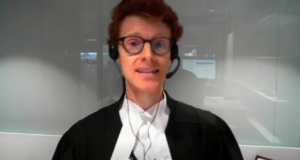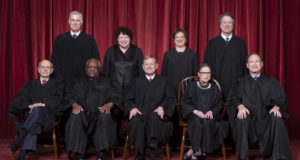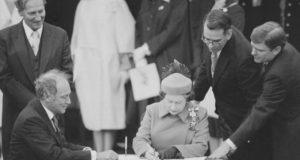Double Aspect, the law blog of Leonid Sirota and Mark Mancini, recently hosted The 12 Days of Christmas, in which contributors offered their picks for the five worst public law Supreme Court of Canada decisions between 1967 and 2017. My list included Andrews, which I criticized for starting the mess that the Supreme Court has made of section 15(1) of the Charter. I took no issue with the result in Andrews but suggested that its confused interpretation of s 15(1) has made possible the Court’s assertion that it protects substantive equality. In a recent post here at ARL, Jesse Hartery takes issue with my criticism of Andrews and defends the notion that substantive equality is the kind of equality that s 15(1) guarantees.
I am delighted that Mr. Hartery has taken up this issue and grateful to Asher Honickman and ARL for giving us an opportunity to debate it. The equality guarantee has become the elephant in the Canadian constitutional courtroom. In its recent TWU decision, the Supreme Court invoked equality as a “Charter value” that justified the infringement of an explicitly enumerated fundamental freedom. Yet 15(1) is just another section of the Charter. It provides that every individual is “equal before and under the law and has the right to the equal protection and equal benefit of the law without discrimination …” What does that mean? It is not a small question. In this article, I will identify the main alternatives and discuss implications of the interpretation that Mr. Hartery advocates.
Formal versus substantive equality
Section 15(1) lists four variations of equality (“before”, “under”, “protection” and “benefit”) but there are only two core competing ideas: equality means either that the same rules should be applied to everyone or that different rules should be applied to different people so as to produce equal outcomes.
The first concept, often referred to as “formal equality” or “equality of application”, lies at the heart of Western legal culture: All individuals should be subject to the same rules and standards; like cases should be treated alike; justice should be blind; the law should take no account of personal characteristics and should treat people as individuals rather than as members of groups. The second notion, commonly known as “substantive equality” or “equality of outcome”, is the opposite of the first: equality does not mean treating people the same but requires treating them differently so as to achieve equal or equivalent effects; justice should not be blind but should inquire into identities, capacities and practices; the law should make distinctions based upon group affiliation and treat people in proportion to their group’s advantages and disadvantages, strengths and weaknesses.
Formal equality and substantive equality are mutually exclusive and cannot co-exist. The law cannot simultaneously apply the same rules to everyone and also apply different rules to different people. One person’s right to have the same rules and standards applied universally is inconsistent with another’s right to have a rule modified or waived because of its differentiated burdens. Under 15(1), it must be one thing or the other. The section may describe equality using a variety of terms but it cannot guarantee both formal and substantive equality because they are incompatible.
How formal and substantive equality work
The term “formal equality” does not denote merely that formal rules should be neutrally applied in adjudication. For example, a rule might state that “Men must report for military duty”. If a court applied this rule according to its terms in a neutral manner to men and women, that adjudication would send only men to compulsory military service. The rule is inconsistent with the requirements of formal equality because it imposes different obligations on men and women.
If, instead of explicitly requiring men to report for military duty, the rule required everyone with an Adam’s apple to do so, the substance of the rule is the same: the requirement applies to men and not women. Under a regime of formal equality, courts can examine substance to ensure that the same standards are being applied to all; whereas the premise of substantive equality is that the same standards should not apply to everyone. Where substantive equality is the objective, courts examine substance to measure whether the standards will be more difficult for some to meet than others. A rule might require that all volunteers for military duty be able to run a mile in under ten minutes wearing heavy boots. That rule establishes a common standard for all recruits. It meets the requirements for formal equality. However, if the average man runs faster than the average woman, the rule does not comply with the requirements for substantive equality because as a group women will have a greater challenge meeting the standard than men.
The case for substantive equality
According to Mr. Hartery and the Supreme Court of Canada, 15(1) should protect substantive equality. In Andrews, McIntyre J. stated:
… a law which treats all identically and which provides equality of treatment between “A” and “B” might well cause inequality for “C”, depending on differences in personal characteristics and situations. To approach the ideal of full equality before and under the law … the main consideration must be the impact of the law on the individual or the group concerned. Recognizing that there will always be an infinite variety of personal characteristics, capacities, entitlements and merits among those subject to a law, there must be accorded, as nearly as may be possible, an equality of benefit and protection and no more of the restrictions, penalties or burdens imposed upon one than another. In other words, the admittedly unattainable ideal should be that a law expressed to bind all should not because of irrelevant personal differences have a more burdensome or less beneficial impact on one than another.
Mr. Hartery concurs. He uses anti-sodomy laws to illustrate. He says, and I agree, that a law that prohibits homosexual but not heterosexual sodomy would fail to meet the requirements of formal equality, since it does not prescribe the same rule for all. However, he goes on to argue that a rule universally prohibiting anal intercourse is contrary to the 15(1) equality guarantee because it has different effects upon gay people than straight people. He writes:
While heterosexuals would not be deprived of the ability to engage in consensual sexual intercourse with another human being, gays would effectively be barred from engaging in such intercourse based solely on their sexual orientation. Put differently, it would deny gay people a choice which the legislature has given to heterosexual peoples. This would deny them equality under the law and equal benefit of the law. Therefore, as McIntyre J suggests, identical treatment on its face may produce serious inequality.
Substantive equality: Rights for some but not for others
A rule prohibits hunting. The rule applies to everyone. Under the rule, no one may hunt. However, the rule impacts only people who hunt. People who do not hunt are not burdened by the rule because it prohibits something that they do not do. The rule applies equally to all but its burdens are not equal. Does the rule infringe section 15(1)? If 15(1) protects formal equality, then the answer is “no” because the prohibition applies to everyone. If 15(1) provides substantive equality, then following Mr. Hartery’s logic, the hunters would seem to have a case. The rule burdens them and no one else. The problem is that 15(1) reserves substantive equality to select populations. Hunters are not among them because hunters are not the right kind of group.
Mr. Hartery says that if sodomy is prohibited, 15(1) is infringed because the prohibition affects gay people more than straight people. However, a rule that prohibits sodomy is abstractly the same as a rule that prohibits hunting. Both rules apply to all without exemption and comply with the requirements for formal equality. Both prohibit activities in which any adult could otherwise engage. Gay and straight people practice sodomy; anyone can hunt. Each rule affects only those people who participate in the activity. They apply equally to all but their burdens are not equal. Mr. Hartery says gay people should be protected from the prohibition against sodomy because 15(1) protects substantive equality. Yet hunters have no claim for relief from a ban on hunting – except perhaps if they are Aboriginal. The right to substantive equality is available only in select circumstances to a privileged few.
Mr. Hartery suggests that a ban on sodomy is unequal because sodomy is an inherent part of homosexuality. However, it is not an innate feature like having an Adam’s apple. Homosexuality itself may be innate but sodomy is an activity in which, like hunting, both gay and straight people may choose to engage. A ban on vaginal intercourse would meet the requirements of formal equality since the prohibition is universally applicable. The fact that only straight people choose to participate is irrelevant. Gay people simply do not wish to partake – just like people who opt not to hunt. If prohibiting vaginal intercourse is valid under 15(1), so too is banning sodomy. The law should not care who you are.
Equality is not liberty. I agree that people – gay, straight or otherwise – should not be prevented from engaging in whatever kind of sexual activity they wish. Governments have no business imposing rules on sexual conduct between consenting adults. However, that is an argument for liberty, not equality. Liberty is the right to be free from state interference. Equality is the right not to be subject to different oppressive rules than anybody else. The notion of substantive equality is apt to be pursued as a route to liberty for aggrieved groups, but that is riding the wrong horse to the wrong pasture.
The words of section 15 of the Charter
I am not suggesting that hunters should have a right to substantive equality. They should not. Nor should gay people, Aboriginal hunters or female military recruits because that is not what the words of 15(1) prescribe. The text of 15(1) precludes substantive equality: “Every individual is equal … without discrimination…” The section applies to individuals, not to groups. (The word “group” appears in 15(2) but not in (1).) To which individuals does the guarantee in 15(1) apply? Every single one, without regard to whatever group affiliations they might claim: gay or straight, black or white, male or female, rich or poor, hunters or vegetarians. The words of 15(1) describe a universal right to formal equality.
In the English language, “to discriminate” means to distinguish or to tell apart. To apply different standards to different people is to discriminate. The very idea of substantive equality discriminates because it distinguishes between people based upon their group identities. The text of 15(1) prohibits it: “…without discrimination and, in particular, without discrimination based on race, national or ethnic origin, colour, religion, sex, age or mental or physical disability.” The words of the section say that the law should not distinguish between people on the basis of identity. Do not inquire into who they are, it says. Make and apply rules without recognizing distinctions between them.
The text of 15(2) demands this interpretation also. Section 15(2) is a specific and narrow exception to 15(1). The opening words of 15(2) say “Subsection (1) does not preclude …” Section 15(2) provides for specific programs that seek to achieve substantive equality. It conflicts with the principle of formal equality in 15(1). If it did not, there would be no need for the words “Subsection (1) does not preclude …”. Indeed, there would be no need for 15(2) at all. If 15(1) and 15(2) both protect substantive equality, then 15(2) is redundant.
All individuals are equal but some are more equal than others
Substantive equality is a licence to discriminate. Non-Aboriginals may be prohibited from hunting and fishing when Aboriginals are free to do so but not the other way around. Female military recruits may get longer to run a mile than male recruits even if some are better runners than some of the men. What of the slow white male who wants to join the military, hunt and fish? He has the worst of all constitutional worlds. He can neither insist that the same rules be applied to everybody nor claim to belong to the right kind of group to have the rules adjusted in his favour. The words of 15(1) say that every individual is equal but he is not one of them. Substantive equality makes some more equal than others.
Bruce Pardy is Professor of Law at Queen’s University. E-mail him at pardyb@queensu.ca. Follow him on Twitte @PardyBruce
 Advocates for the Rule of Law
Advocates for the Rule of Law




One comment
Pingback: Demagogic Justice: The 2020 Democratic campaign and the reparations moment that is long gone - The Post Millennial